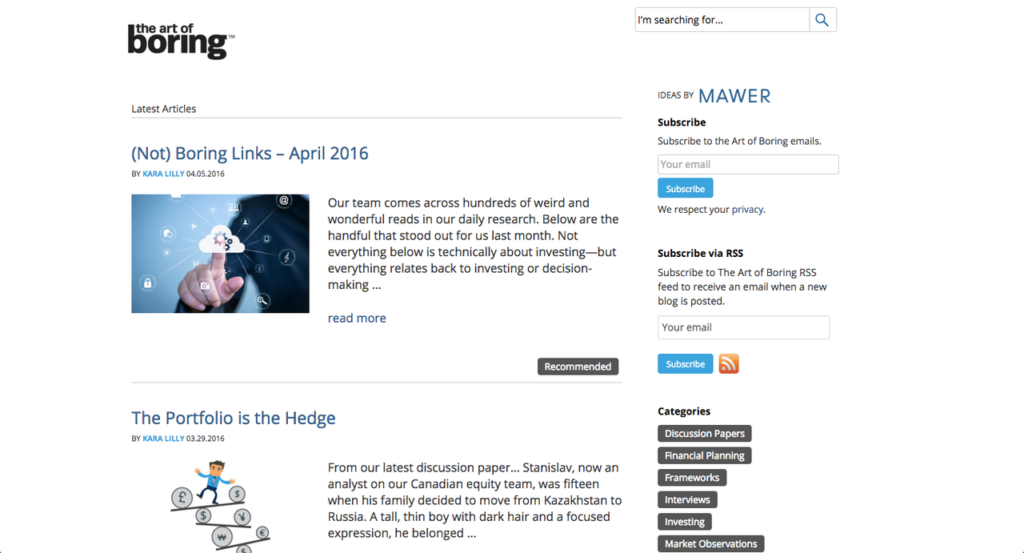A great financial services blog provides relevant content to consumers in a way that inspires them to engage with your company. Ideally, this content doesn’t just cater to your existing customers, but brings in potential customers as well.
This is why we love Mawer’s Art of Boring blog! Using creativity to engage with a wider audience generates leads. It is a commonly held belief that the topic of financial services is one that is not very exciting. However, Mawer capitalizes on this by transforming boring into an “art”. By flipping the switch on their business genre, companies are able to generate leads that would not typically eat up this type of content.
Example of a Great Financial Services Blog
This fact doesn’t escape them either. The irony of the name “The Art of Boring” itself references that this topic is considered “boring” by so many.
Yet the blog itself is immensely interesting!
By employing a lighter take on the topic of financial services, their content becomes more readable as well as relatable. For example, using a metaphor of the cleanliness and availability of toilet paper in China’s washrooms to describe a greater cultural shift makes this article fun to read. This appeals to anyone who has had a bad public washroom experience – which is a wide audience of people.
Humour is a great way to connect with people
Humour is a great way to connect with people. Period. Many content contributors use this method to engage their readers and lighten up the, often dry, world of financial services. We could not help but chuckle at the tale of Kara Lilly’s battle with strawberry yogurt but then learned something very valuable about the keystone business model.
Lightening up serious topics with humorous and relatable anecdotes is an excellent strategy for engaging consumers… It worked on us!
One reason why financial services blog content is not readily consumed by the average person is that so much of the it is filled with industry jargon. Most of this content is seemingly written for other financial services companies. Not for their real audience.
If you cut the industry jargon and take the time to deliver real and consumable information, the result is an engaged consumer. Someone in a more trustworthy relationship, which is likely to last longer. Even when catering to those that know their stuff, consumers appreciate directness. This is particularly true when it comes to the management of their hard earned money.
Tweet: “Understanding your audience is THE most important facet of developing content”
So, what do consumers really want to read about in a financial services blog?
This would truly depend on who your target audience is. If you are aiming to appeal to a someone who is not the most investment savvy, then they are likely to appreciate direct, clear-cut instructions on what they need to do. This will put them in a good position for retirement or relatable stories delivered through content that resonates with them.
This audience will be easily overwhelmed by numbers and percentages being thrown at them or discussions in an analyst’s report. If you are trying to target industry professionals, or those that are well versed in this space, then you can take the complexity up a notch and dive deeper into current issues. This leads us into our next point: the importance of understanding your audience.
Understanding your audience
Understanding your audience is THE most important facet of developing content because it dictates what content to produce! This includes the tone and message to convey. On one end of the spectrum, you do not want to overwhelm your readers with information that they are unable to comprehend.
However, if you dumb it down too much, the content will be a waste of time for the advanced investor and may insult their intelligence. These are obviously the two extremes on this scale, but there are many more ways to miss your mark if you do not understand your audience. Do your research to find out what your ideal consumer wants to read. Then, consistently evaluate the results of each piece. This will ensure that you are on the right track.
Mawer is brilliantly at employing the concept of writing about everything including financial services instead of just financial services. I really could not say it better than they have already done so in their (Not) Boring Links – April 2016 post:
“Not everything below is technically about investing—but everything relates back to investing or decision-making in some way.”
Frozen yogurt or gelato?
Blogs provide a way for people to stay up-to-date on everything that is going on in the world. If your corporate blog can be a source of a variety of information, then you might just find them visiting more often and engaging with the blog more consistently. You can grab and keep your audiences’ attention much better by covering a variety of topics.
Mawer shows us that producing a high quality blog truly is an art. In other words, when writing for a Financial services blog, boring is definitely not the norm. You can connect with readers using humour. You can also provide content that directly speaks to them and cuts through the industry jargon. A Financial services blog can also cover a variety of topics which allows them to engage consumers in multiple ways.
Are you looking to start producing your corporate blog or enhance your existing one? In that case, The Art of Boring is an excellent example. It illustrates how this marketing vehicle can be optimized to capture leads by engaging with prospects before they’re really in the market or actively searching for solutions.
Not everyone who reads The Art of Boring will be an investment clients of Mawer’s. Though, you can be sure that when they are ready, they will be turning to Mawer first.


Leave A Comment